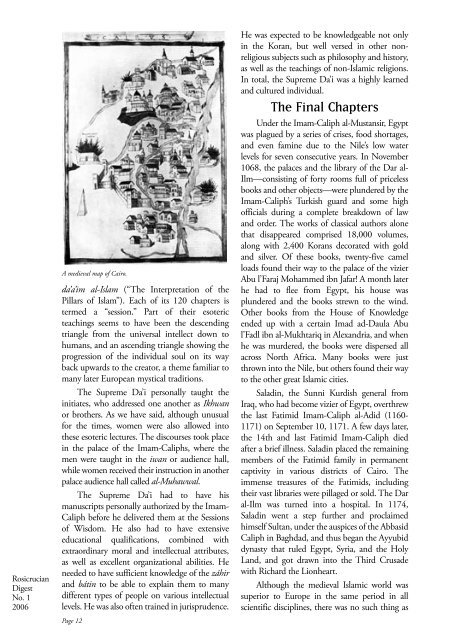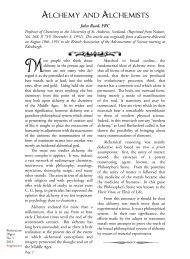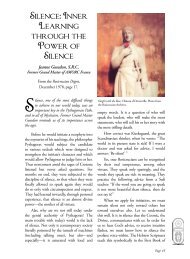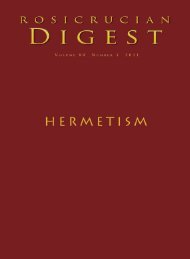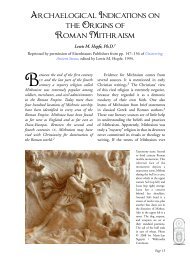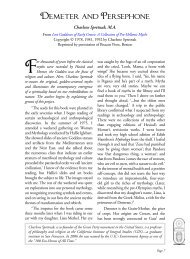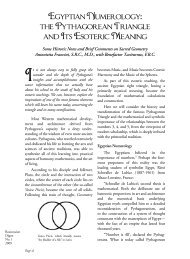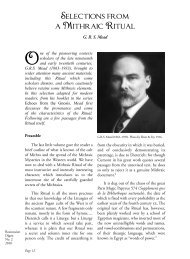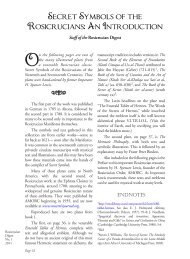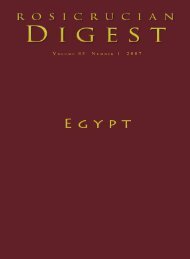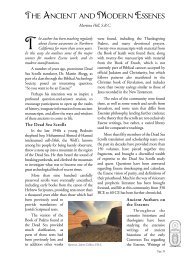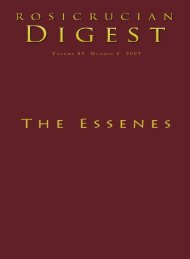The Grand Temple - Rosicrucian Order, AMORC
The Grand Temple - Rosicrucian Order, AMORC
The Grand Temple - Rosicrucian Order, AMORC
Create successful ePaper yourself
Turn your PDF publications into a flip-book with our unique Google optimized e-Paper software.
He was expected to be knowledgeable not only<br />
in the Koran, but well versed in other nonreligious<br />
subjects such as philosophy and history,<br />
as well as the teachings of non-Islamic religions.<br />
In total, the Supreme Da’i was a highly learned<br />
and cultured individual.<br />
<strong>Rosicrucian</strong><br />
Digest<br />
No. 1<br />
2006<br />
A medieval map of Cairo.<br />
da’a’im al-Islam (“<strong>The</strong> Interpretation of the<br />
Pillars of Islam”). Each of its 120 chapters is<br />
termed a “session.” Part of their esoteric<br />
teachings seems to have been the descending<br />
triangle from the universal intellect down to<br />
humans, and an ascending triangle showing the<br />
progression of the individual soul on its way<br />
back upwards to the creator, a theme familiar to<br />
many later European mystical traditions.<br />
<strong>The</strong> Supreme Da’i personally taught the<br />
initiates, who addressed one another as Ikhwan<br />
or brothers. As we have said, although unusual<br />
for the times, women were also allowed into<br />
these esoteric lectures. <strong>The</strong> discourses took place<br />
in the palace of the Imam-Caliphs, where the<br />
men were taught in the iwan or audience hall,<br />
while women received their instruction in another<br />
palace audience hall called al-Muhawwal.<br />
<strong>The</strong> Supreme Da’i had to have his<br />
manuscripts personally authorized by the Imam-<br />
Caliph before he delivered them at the Sessions<br />
of Wisdom. He also had to have extensive<br />
educational qualifications, combined with<br />
extraordinary moral and intellectual attributes,<br />
as well as excellent organizational abilities. He<br />
needed to have sufficient knowledge of the záhir<br />
and bátin to be able to explain them to many<br />
different types of people on various intellectual<br />
levels. He was also often trained in jurisprudence.<br />
Page 12<br />
Under the Imam-Caliph al-Mustansir, Egypt<br />
was plagued by a series of crises, food shortages,<br />
and even famine due to the Nile’s low water<br />
levels for seven consecutive years. In November<br />
1068, the palaces and the library of the Dar al-<br />
Ilm—consisting of forty rooms full of priceless<br />
books and other objects—were plundered by the<br />
Imam-Caliph’s Turkish guard and some high<br />
officials during a complete breakdown of law<br />
and order. <strong>The</strong> works of classical authors alone<br />
that disappeared comprised 18,000 volumes,<br />
along with 2,400 Korans decorated with gold<br />
and silver. Of these books, twenty-five camel<br />
loads found their way to the palace of the vizier<br />
Abu l’Faraj Mohammed ibn Jafar! A month later<br />
he had to flee from Egypt, his house was<br />
plundered and the books strewn to the wind.<br />
Other books from the House of Knowledge<br />
ended up with a certain Imad ad-Daula Abu<br />
l’Fadl ibn al-Mukhtariq in Alexandria, and when<br />
he was murdered, the books were dispersed all<br />
across North Africa. Many books were just<br />
thrown into the Nile, but others found their way<br />
to the other great Islamic cities.<br />
Saladin, the Sunni Kurdish general from<br />
Iraq, who had become vizier of Egypt, overthrew<br />
the last Fatimid Imam-Caliph al-Adid (1160-<br />
1171) on September 10, 1171. A few days later,<br />
the 14th and last Fatimid Imam-Caliph died<br />
after a brief illness. Saladin placed the remaining<br />
members of the Fatimid family in permanent<br />
captivity in various districts of Cairo. <strong>The</strong><br />
immense treasures of the Fatimids, including<br />
their vast libraries were pillaged or sold. <strong>The</strong> Dar<br />
al-Ilm was turned into a hospital. In 1174,<br />
Saladin went a step further and proclaimed<br />
himself Sultan, under the auspices of the Abbasid<br />
Caliph in Baghdad, and thus began the Ayyubid<br />
dynasty that ruled Egypt, Syria, and the Holy<br />
Land, and got drawn into the Third Crusade<br />
with Richard the Lionheart.<br />
Although the medieval Islamic world was<br />
superior to Europe in the same period in all<br />
scientific disciplines, there was no such thing as


